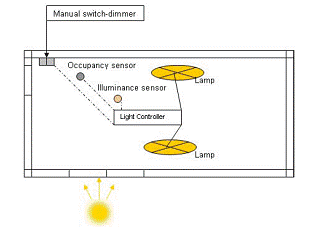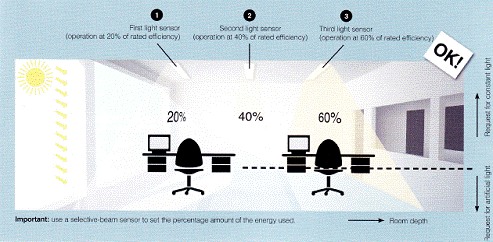Lighting Technologies & Controls: Services
6- Controls & Managements of Light & Energy:
The primary lighting controller known and most widely used is the manual switch to put the luminaries on or off. This type of control is not robust enough with respect to energy efficiency as it relies solely on the behaviour of the occupants who are not necessarily concerned by energy savings. (Liisa Halonen, Eino Tetri & Pramod Bhusal, ANNEX 45, Espoo 2010). However, advanced lighting control systems depend mainly on occupancy sensors and daylight harvesting sensors. A layout configuration is shown in the right figure.
Lighting control strategies provide additional cost-savings through real time pricing and load shedding. Reducing lighting power during electricity peak-use periods - when energy rates are at the highest - can also be achieved through a Lighting Management System (LMS). Lighting Management Systems allow building operators to integrate lighting systems with other building services such as heating, cooling, ventilation, in order to achieve a global energy approach for the whole building, in particular for green building or an energy-producing building. (Liisa Halonen, Eino Tetri & Pramod Bhusal, ANNEX 45, Espoo 2010)
Managing energy is the key to maximising its usefulness and economising on its waste. While there are increasing numbers of products that are now more energy efficient than their predecessors, controlling switching or reducing settings of variables such as temperature or speed, makes the greatest impact. (Advanced Lighting Guide, New Building Institute, Inc., 2003 edition)




